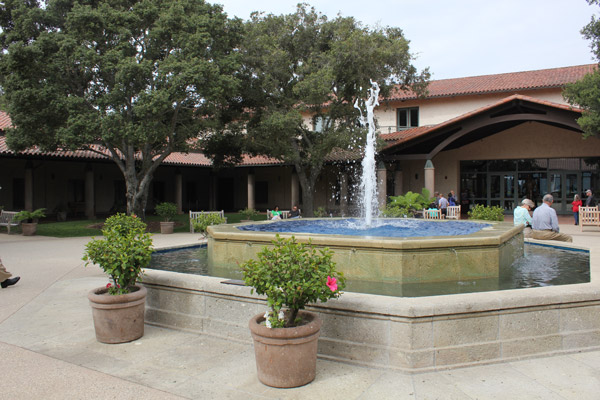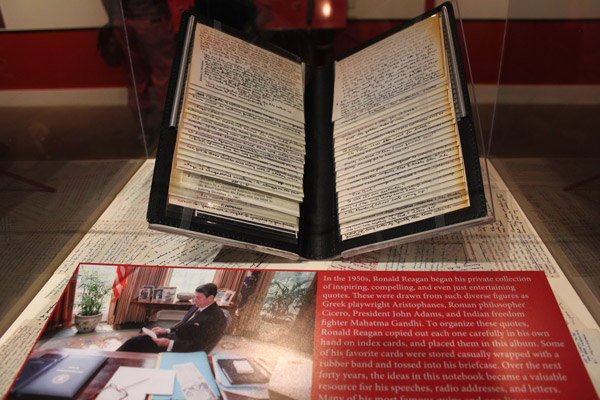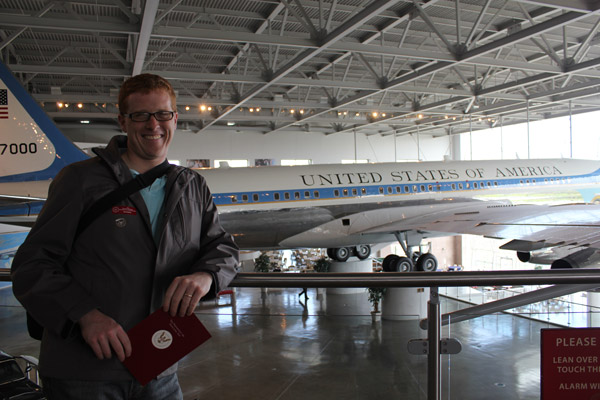Presidents: Ronald Wilson Reagan
Tampico and Dixon, Illinois
Visited in 2014.

Welcome to Tampico, the town that sort of beat the Russians!

Tampico: I don't know why, but the artist clearly hated young Reagan.

Downtown Tampico, across from the Reagan birthplace.

A closer shot of the museum entrance. There probably won't be a line.

Tampico's number one stop for all your Ronald Reagan needs.

Checking out the re-creation of the Depression-era bank.

Inside the Reagans' old apartment, where Ronnie was born.

The Reagans' apartment, or at least a best guess at how it looked.

The rest of downtown Tampico. It makes Smallville look like Hugeville.
In the early days of America, farms were more or less self-sufficient. You could eat the food you grew, make clothes from the animals you raised, force your children to serve as cheap labor, and discreetly worship a pagan harvest deity away from the prying eyes of nosy neighbors.
Modernization changed all that. As people settled the Midwest, farms were smaller and more specialized, making them less likely to provide all your dietary needs. People got accustomed to cheaper, sturdier manufactured clothes and goods. Annoying laws said you had to send your kids to school, and nice Christian churches started to spring up all over the place.
All these services had to have a delivery point, so America needed towns like Tampico, Ill. There were farms 10 miles in any direction, but "downtown" Tampico had a bakery, a grocery, a short-line railroad stop, a post office and a few churches. The population probably got a lot bigger on the weekends, when everyone came in from the farms to see (and talk crap about) their neighbors.
They also probably shopped at the Pitney Variety Store for all their dry goods needs. Jack Reagan worked there, and in 1911 he was renting a six-room apartment above the bakery across the street. On Feb. 6, his wife gave birth to their second son, right there in the apartment. The Reagans weren't Dutch, but they came from a part of Illinois that was lousy with them -- Jack grew up in Fulton, a town on the Mississippi River which still boasts a windmill. He supposedly thought his kid looked like a "fat little Dutchman," and the nickname stuck.
Ronald Reagan defeated an entire economic paradigm and also starred in a movie with a chimpanzee. Naturally, it's interesting to see where such an amazing career began. Tampico is (cough) more humble today than it was in 1911. The population (800) is half the size, and the two-block downtown isn't exactly thriving. The Dutch Diner closed, the grain silo looks beat to hell and there isn't a dry goods store anymore.
But there is a museum. A very nice grandmother showed me around the bank that replaced the bakery. It's restored to a Depression-era look, when banks were at their absolute finest. There's also a room of Reagan memorabilia organized like the back room of an antique store. If you want, you can buy a T-shirt with a rainbow logo. Apparently, there was a double-rainbow right around the 1980 election, and someone snapped a photo so that one ribbon seems to end right on top of the apartment. Reagan supposedly kept the photo in his desk.
After that, I went upstairs to see the apartment itself. They have everything decorated and organized like the Reagans might have. It's nice, but not extravagant. In a tribute to either terrible design or Midwestern friendliness, the back porch has a window that opens directly into the apartment next door. Apparently baby Ron was passed through the window to the neighbors when his mom needed to run some errands. The tour guide will let you climb through the window if you want. You should go for it.
The Reagans left that apartment a few months after Ron was born. They probably lost their cleaning deposit after having a kid in the front bedroom, but they needed more space. They moved to a house a few blocks away, which is still privately owned and not available for tours, no matter how hard you stare menacingly at the front door. But you can enjoy the nearby park where Ron and his brother used to play on the antique cannons. That childhood romping inspired maybe the ugliest statue of a president ever made.
A few years later, Mr. Pitney sold his store, and the Reagans moved to Chicago. Jack was a hard-drinking guy with a spotty employment record, so relocations were a fact of life for the family. The next few years they bounced around Illinois, even ending up back in Tampico after Pitney reacquired the business. The Reagans stayed over top of the dry goods store during their second stint, and now there's a Reagan mural painted on the side of the building where the store used to be.

Dixon: For three years, this was the Reagan residence. But they moved a lot.

Another view of Reagan's fondly remembered boyhod home.

Reagan's room, restored to what was probably the World War I era.

Getting in some porch time with the Reagan family.

Heading toward downtown Dixon on a rainy day. It's huge, compared to Tampico.

Lowell Park, where young Ronald pulled a lot of swimmers out of the water.
But it was just another pit stop. In 1920, Pitney decided that he trusted Jack enough to open a store called the Fashion Boot Shop. The family headed northeast, to a town on the Rock River called Dixon. They rented a house for $15 a month. After three years, the rent got jacked up, and they moved again -- the Reagans ultimately had five different homes in Dixon. But Ron considered the first home his favorite, and it's the one they bothered to save.
The Dixon site is fancier than the Tampico site. They have a separate building for a visitor center, and there's a nice informational video that can't be more than 30 years old, which is pretty good for a presidential site. Reagan visited Dixon in 1984 for his 73rd birthday. They renovated the home in advance of the party, and you're seeing the results today. The boys' bedroom was gussied up with boy-bedroom type things, and the dining room table is set the same way it was when Reagan ate there in 1984. Ron used to hide pennies under a tile near the fireplace, to keep them away from his older brother. He put a few more there on his 1984 visit, so they have the tile overturned. They could have left a few of Jack's empties around, but they didn't want to be totally authentic.
They share stories about the usual boyhood hijinks, but it's not a very big home. The whole experience takes about 30 minutes. I rounded out the day by driving to Lowell Park, where Reagan was a teenaged lifeguard. There might have been some kind of marker there, but it was pouring buckets. I was happy to sit in the car and stare at the river, like a frazzled private investigator wondering if the body would ever surface.
Ronald Reagan Presidential Library and Museum, Simi Valley, California
Visited in 2014.

Come for the views, stay for the Reagan Library and Museum.

Reagan's museum definitely invokes California cool.

Looking back at the entrance, to make sure Allyson wasn't running off.

Saying hello to our gracious hosts.

A shot of Reagan during his radio days. The guy knew how to communicate, yo.

Reagan's portfolio of jokes and anecdotes. Again, he knew how to communicate.

They're heavy on the interactive stuff. It's actually pretty fun.

All I keep on my desk is empty Diet Coke cans. Sigh.

The replica of Reagan's Oval Office. Hey, remember the '80s?
Illinois has been dining out on Abraham Lincoln for decades, but only one president REALLY came from state. Ronald Reagan was born in the farm town of Tampico. Thanks to an itinerant and hard-drinking dad, he got to live in a few parts of Illinois, each one earthier than the last. Reagan eventually built a career around Midwestern stereotypes: straightforward communication and a positive demeanor. He was so good at being Midwestern that he achieved the dream of many Midwesterners. He moved somewhere else.
In the middle of a California vacation, my wife and I woke up on a Friday and headed to the place where Reagan is buried. The only non-negotiable requirements I had for a California vacation were visits to the Reagan library and the Nixon library, the most prominent presidential sites on the West Coast. Allyson agreed to these terms, even when I decided it would be best to see both libraries on the same day. She might have low-grade Stockholm syndrome.
Reagan lived in Santa Barbara, but when you need scenic views at affordable prices, you go to Simi Valley. There are low, rocky mountains with views for miles, and the library is at the top of one of them. It looks like a California mission from the front: It's a low-slung building with a courtyard and ceramic roof tiles. We were there early enough that I upgraded my ticket to become a "library friend," a status that comes with an ID card and free admission to any other presidential library for a year. It also comes with a tiny bit of shame when someone asks, "Hey, what's that card in your wallet?"
The museum is a whitewash. They gloss over Reagan's first marriage and all of his kids, and there's surprisingly little about Reagan's advisers or opponents. It took the combined efforts of at least six people to defeat communism and restore faith in the American dream, but the library tries to keep the spotlight entirely on Ron. They're going for the Hollywood version, which I suppose is the most Reagan thing they can do.
Although Reagan was born in Tampico, his story really got going in Dixon. Reagan was a gregarious and popular kid. He was a lifeguard at a local park, where he personally made 70 future Republicans by pulling them out of the Rock River. As a young man, he landed a job as a radio announcer in Iowa. Before long he talked his way into a gig doing play-by-play for the Chicago Cubs on the local feed. On a baseball road trip to California, he auditioned with Warner Brothers, which got him into the movies.
Reagan was a Democrat back then. He wasn't a tremendous actor, but he was chosen as president of the Screen Actors Guild. He took the union through some labor-management disputes in the late 1940s. For most of the 1950s, he was the host of "General Electric Theater," an anthology TV show. In addition to putting him in American homes every week, the job gave Reagan the chance to visit scores of GE facilities around the country and talk to business groups as the company's goodwill ambassador. He morphed into a business-friendly conservative and famously campaigned for Barry Goldwater in 1964. With his bona fides established, he successfully ran for governor in 1966. Then a few minor, inconsequential things happened before his death in 2004. I won't bore you with those details.

Apparently it was a board game. Hurry, buy it and play it ironically!

Technically it ain't Air Force One without a president on it, but oh well.

Underneath the Boeing 707. (No pictures allowed inside.)

Not as cool as the Nixon library's chopper, but still pretty cool.

Not three seconds later this fake horse threw me 20 feet through the air.

A piece of the Berlin Wall, which Reagan got Mr. Gorbachev to tear down.

Approaching Reagan's grave.

The beautiful view from Reagan's gravesite. Yowza.
Even if it is a whitewash, the museum is very slick. They have a green screen kiosk where you can do a scene with Reagan from "Knute Rockne: All American." (I redefined the role of the guy who can't hide the fact that Knute is about to keel over dead.) Reagan's personal diary is entirely digitized, and there is a terminal that lets you read the entry from any date. A room dedicated to the 1981 assassination attempt has the suit Reagan was wearing that day, bullet hole and all. Reagan loved collecting humorous and inspirational stories for his speeches, and you can see the small leather portfolio where he wrote them down and organized them. His hand-marked notes from the "Tear Down This Wall" speech show his personal thoughts on diction. There's an exact replica of Reagan's Oval Office. He kept portraits of George Washington and Andrew Jackson on the walls, sculptures from Frederic Remington on the shelves and jars of jelly beans on the tables. Reagan also had a simple placard on his desk; written on red leather in gold lettering is the simple phrase, "It can be done." It was either a statement of his famous optimism or the token that helped him move forward when deciding whether to get more arms to the Contras.
The museum's most well-known feature has only a marginal connection to Reagan. It is a retired Air Force One, housed in a custom-built hangar with a huge glass window overlooking the countryside. The plane is a Boeing 707, so it's tiny compared to the modern Air Force One. (If you've flown with Southwest, you've achieved a comparable level of luxury.) A lot of ridiculously important people flew on that plane, but if any of them had illicit affairs or coke parties on board, the people at the Reagan library aren't talking. They also have a Marine One in the hangar, but there aren't any good stories about the president taking it to White Castle or anyplace fun. It's a bit of a letdown.
Personally, I was more drawn to the most Reagany thing imaginable. Reagan's grave is outdoors, next to a small replica of the White House's south lawn. There's a stone pavilion, and a wall behind Reagan's grave marker has a single quote: "I know in my heart that man is good, that what is right will always eventually triumph, and there is purpose and worth to each and every life." Allyson and I mulled that over while having a conservative lunch at conservative prices in the on-site cafeteria. I sold the Reagan library to Allyson as "one of the fun ones," and she agreed that we were close enough to fulfilling that promise.
Whew.
